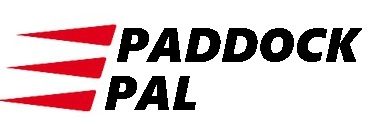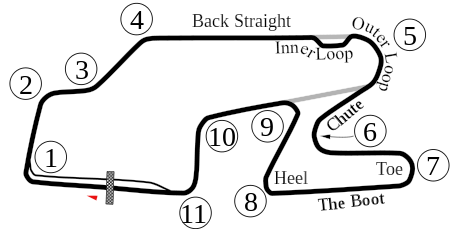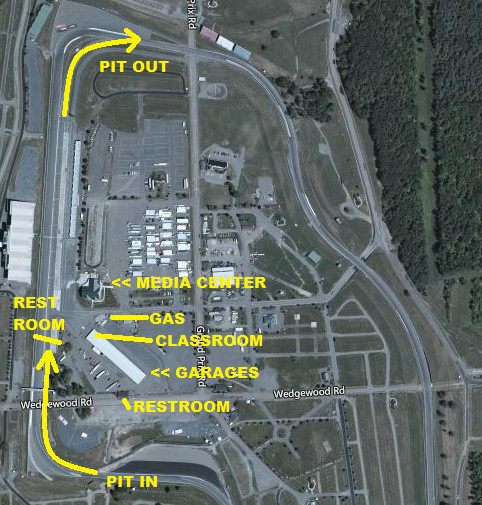
Watkins Glen International, nicknamed "The Glen", is an automobile race track located in Watkins Glen, New York, at the southern tip of Seneca Lake. - Learn more on: Wikipedia
NOTE: This is a dynamic page, if this page is not displaying any data, please use the TRACK GUIDE menu to reselect this venue!
| Travel Guide | Turn-by-Turn |
Passing Zones
Note: All passing zone data depicted below is based on "advanced driver" rules, if you are in a different run group please consult your organization or chief instructor for passing zones that are appropriate for your run group.
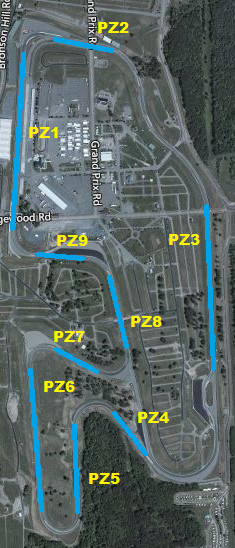
Turn-by-Turn (Front Half)
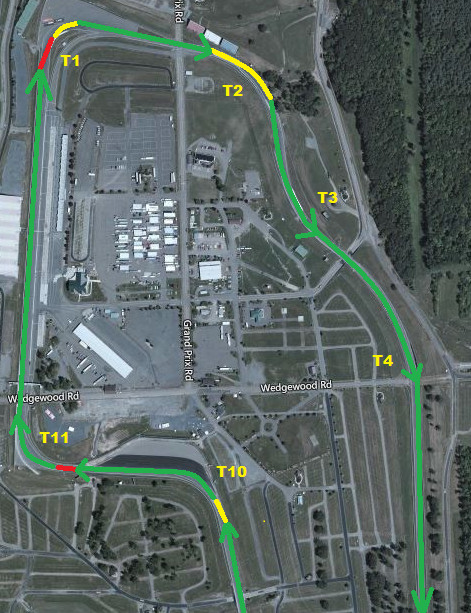
- Turn 1: A 90 degree heavily banked right hander. The line through turn 1 is quite close to a circular arc, that is, the line is not flattening as much as in a typical turn. The reason for this is banking - the car is moving uphill from the apex to the track out curb and therefore has a lot of grip that can be used for acceleration while remaining at nearly full lateral load.In turn this extra grip makes mastering turn 1 challenging - it is a much faster turn than many drivers grant it. It is very easy to overbrake the car, and doing so costs dearly in lap time.Turn 1 benefits greatly from trailbraking. I trailbrake up to 3/4 of the way across the track from the left side to the apex. The track goes downhill until the apex, and trailbraking provides front tires with the crucial additional grip to turn.Scrubbing speed by understeering through the turn in phase is also significant. Turn 1 rewards a neutral handling car.
Use the apex curbing; right front tire should go over the flat part of the apex curb. If you do not hear and feel the tires driving over the apex curb, the car is missing the true apex by 2-3 feet.
There is a huge amount of runoff which is mostly utilized by racers. Even though the runoff area is paved, putting all four wheels left of the exit curb is considered a "four off" by many clubs.
Higher horsepower cars and 10/10ths driving attempts will want to (carefully) use exit curbing, at least the inside half of it that slopes up.
As lower horsepower or high grip cars can take turn 2 and the esses flat out, for them the back straight begins around the apex of turn 1 making turn 1 the most important turn on the track. Especially for lower horsepower cars gains in turn 1 are worth a huge amount in overall lap time.
- Turn 2: You want a sufficiently late apex to set up for the esses, but not so late that you have to apply a lot of steering input at turn in which scrubs off speed. End of the curb is a good ballpark for the turn in point, but lower power and/or lighter car can start the turn earlier. In lower horsepower cars turn 2 should be taken flat out, medium horsepower cars may need to lift to rotate the car at entry, and high horsepower cars may need to just brush the brakes.
- Turn 3: These are also knowns as the esses. It is a combination of right and left uphill sweepers.Lower horsepower cars should continue to be flat out through the esses. Higher horsepower cars should get on power as early as possible after turn 2 and stay flat out until the braking zone for the bus stop.A good way to work on increasing your speed through the esses in higher horsepower cars is to short shift into the next higher gear and go flat out through them in the higher gear. Then move the shift points down track, a car length at a time.Lower horsepower cars, especially with experienced drivers, can take a variety of lines through turns 3 and 4 while remaining comfortably flat out. Higher horsepower cars and less experienced drivers would often use the end of the curb on the right side of the track between turns 3 and 4 as the turn in point for turn 4.
- Turn 4 "BUSSTOP": A chicane on the back straight that is faster than it looks, and can be made even faster by aggressively - but thoughfully - cutting the curbs.The curbs on the left side are fairly steep and are best avoided. Curbs on the right side can be cut in softer sprung cars. In particular, cutting the exit curb on the right straightens the exit substantially, allowing for a lot more speed to be carried through. I have a separate write-up on this here.Less experienced drivers normally brake for the bus stop in a straight line and hold their speed through the bus stop, accelerating once they clear the third curb if not the fourth one.The fastest line through the bus stop is to brake into it, until the apex curbing on the right, and then be on power from that point forward, cutting exit curbs as necessary to stay flat out. Lower horsepower cars can pull this line off without using curbs; higher horsepower cars will need to cut the exit curbs to stay flat out.
- Turn 10: A deceptively fast left.Most people brake too much for this turn and take it too slowly. Use the entire track width at the exit; runoff beyond the curb is paved and can be used when the turn is taken too fast.The curb is "dented" at the apex, allowing a little bit of additional steering to be added just around the apex.High grip, low power cars can take turn 10 flat out.
- Turn 11: A right hander leading onto the main straight, with the outside wall very close to the edge of the track at the exit.Discipline is required to not apex this turn too early. Most cars will want to be on full throttle at the apex.The ideal line through turn 11 is tricky. There is not as much grip on the concrete patch as there is on pavement, however the concrete patch is right where the school line is and not getting on it is difficult to say the least. I had reasonably good success with turning in at the patch but going outside off of it halfway into the turn. This allows me to get on the power a bit sooner, but with a wider arc the wall comes up faster. Trying to turn in after the patch appears to be somewhere between hard and not advantageous.Similarly to turn 8 there is a groove right at the edge of the curb which effectively banks the turn a bit and provides that extra grip to get on throttle before the apex.
Turn-by-Turn Information provided by

©2018 - Oleg Pudeyev / Race & Track Driving ; with Permission.
Turn-by-Turn (Back Half)
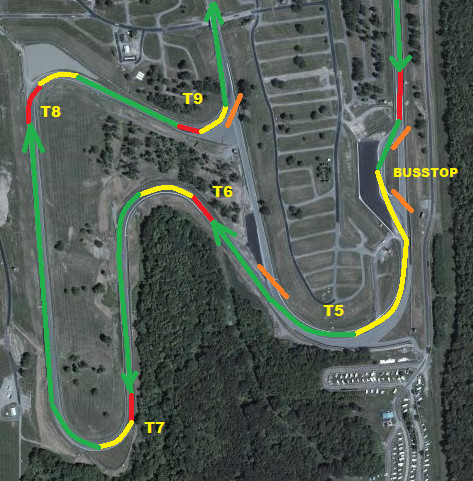
- Turn 5: Blind, fall away late apex right sweeper.Start by tracking out 3/4 of the track width after the bus stop, then do a very slow tightening of the line toward the apex. When you see the apex, stand on throttle, touch the apex and track out all the way to the left edge of the track. Stay off exit curbing as there is no runoff available should the car go sideways over it.1High grip, low horsepower cars can execute turn 5 flat out. Most people lift on entry. High horsepower cars might need to brush the brakes. Because there is a short straight following, you want to execute a late enough apex to be on power as early as possible.
- Turn 6: A downhill left. More speed can be carried through this turn than it first appears. The obvious line is somewhat late which costs a bit of exit speed and a lot of time in corner entry; in a lower horsepower car especially turn in a bit earlier and carry more speed through the turn. Trailbraking deep into the turn works well.In the mornings the braking zone into turn 6 remains in the shade, and as such the track surface there is colder than on the rest of the track. Especially in the first laps on cold tires it is wise to be careful approaching this turn.
- Turn 7: Fairly sharp right, uphill, large elevation gain.Lower horsepower cars need to enter the turn at the highest speed possible because they cannot accelerate up the turn much if at all. A "secant" line through the turn can work well. Unlike most corners, you will not be accelerating at track out even when flat out, therefore initial turn in can be very aggressively early.Higher horsepower cars prefer more of a "standard" line through turn 7.Because the car is going uphill, gravity provides additional grip. As a result the initial turn in can be quite sharp and aggressive, more so than in other, vertically flat corners. Even in understeering cars this can provide good turn in, especially if brake release is appropriately timed.
- Turn 8: Fairly slow right hander.Do not apex early as it will cost time in the 8-9 straight.There is a groove right at the edge of the curb on the inside of this turn. Placing the right front tire in this groove makes the turn effectively slightly banked, thus increasing grip. When I hit the groove I was able to comfortably start accelerating way before the apex.
- Turn 9: Still slow left. Lower horsepower cars will want a slightly earlier apex in this turn, and follow the inside edge of the pavement for about a foot at the apex. Higher horsepower cars will want a late enough apex to achieve full acceleration before it for the following straight.
Turn-by-Turn Information provided by

©2018 - Oleg Pudeyev / Race & Track Driving ; with Permission.
